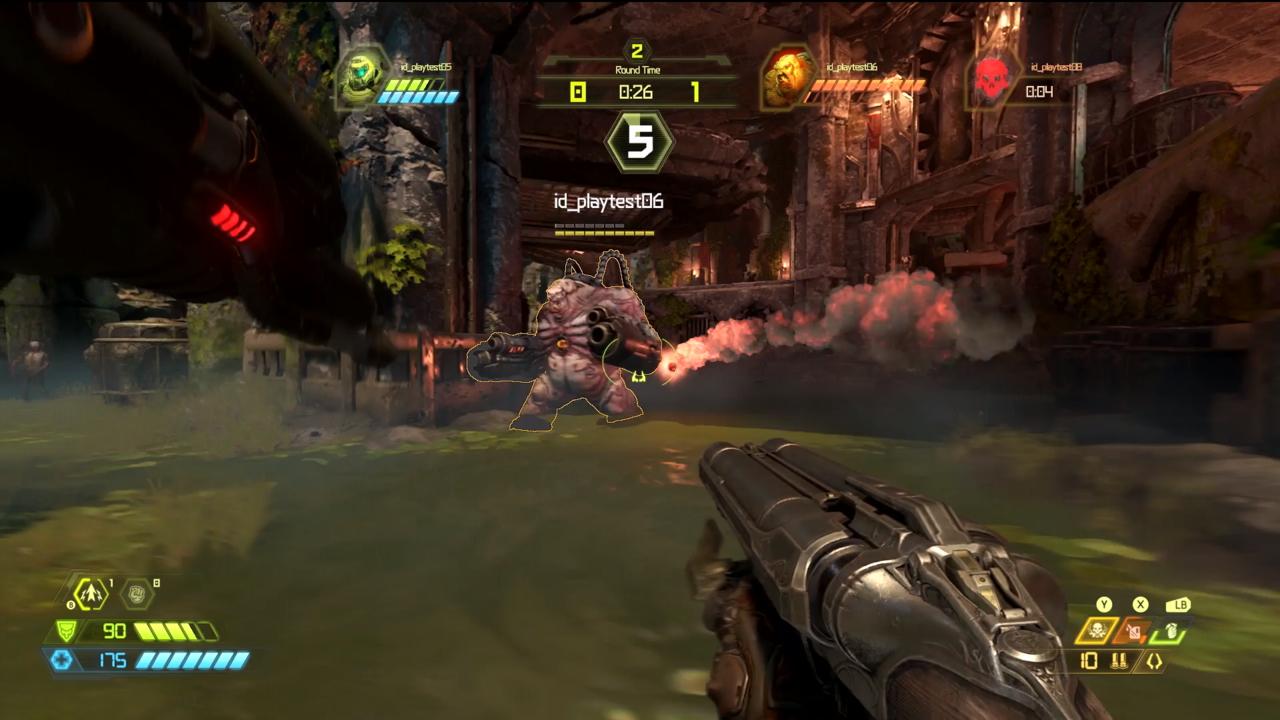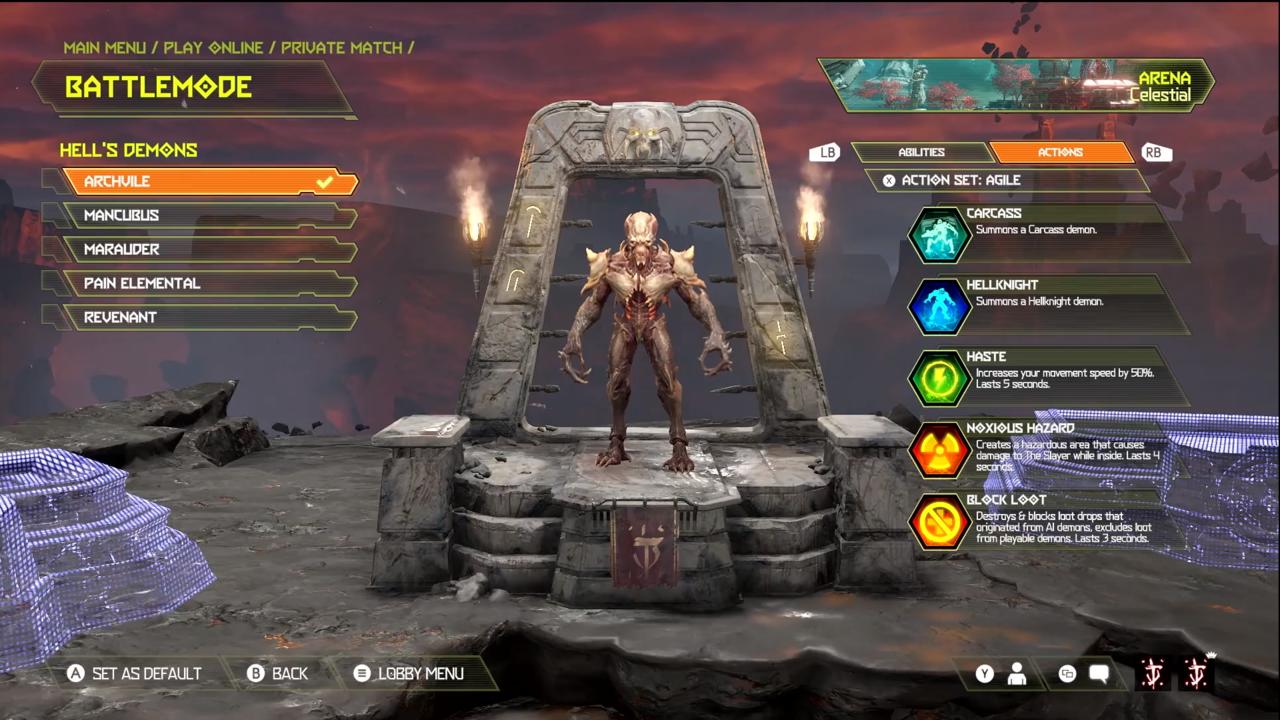Every time I've had the chance to play Doom Eternal, I came away impressed with how its single-player campaign is building on 2016's great foundation while rethinking challenge in FPS combat. It's controlled chaos, pushing you to use the many weapons and tools to rip and tear demons with grace, and reasonably punishing you if you don't. A lot of effort has been put into making these systems work, and recreating that experience for multiplayer has led to what's called Battlemode.
Doom isn't really known for its multiplayer; the somewhat lackluster showing for Doom in 2016 comes to mind. And when we visited id Software recently, Doom Eternal's game director Hugo Martin and executive producer Marty Stratton told us that they knew they had to do something different. There, we got our first hands-on with Battlemode, and saw just how drastically this new multiplayer approach is deviating from convention, yet capturing--sometimes intensifying--the adrenaline rushes you get through the campaign. You'll see what I'm talking about in the video below.
Here are the basics; it's an asymmetrical 1v2 competitive mode with one player as Doom Slayer, equipped with all the single-player capabilities, against two players as demons, with multiple to choose from, each acting like different class-types. In each round, Doom Slayer has to kill both player-demons before either one respawns on a 20-second countdown while the demons just need to kill Doom Slayer. But since Doom Slayer has every capability from the campaign--a full loadout, and the chainsaw, glory kill, and flame belch to keep resources replenished--the demon team has to strategize to win.
Battlemode is an inventive take on asymmetrical multiplayer not just because it breaks new ground, but because it's so close to what Doom does best.
Demons can summon AI-controlled demons, suspend the Slayer's resource gathering for a short period of time, create shields and barriers for protection, and use their own unique attacks (which pull from the demons' actual designs). For example, the Pain Elemental can fly and shoot fireballs while the Mancubus is a slow tank with two devastating arm cannons. Marauder is my personal favorite--it has a throwing axe, double-barrel shotgun, a double-dash ability, and plays a bit similarly to Doom Slayer. Revenant can be quite agile one with jetpacks and quick-firing rockets, while the Archville plays closer to a sort of fire-casting mage class. With five varied demons on the launch roster, withmore to come in the future, the variety between matches can be wild.
When all these elements are firing off at full speed, Battlemode becomes a glorified combat arena. And that's exactly what the team was going for. As Martin said, "It's a very dramatic experience, albeit in bite-sized chunks. We have to have really good pacing and we have to have strategy." He continued, "If you like the Doom single-player, it's a way to have a multiplayer experience within that gameplay and combat loop."

Martin alluded to creating drama as one of the pillars of Battlemode, those sort of edge-of-your-seat moments. Since there is no time limit to each round, one side must win, and because of the mechanics are layered in such a way, the tide can turn for either side in a matter of seconds. I can recall playing a match as Doom Slayer and hunting down the last demon player in the nick of time before the other respawned, or narrowly escaping death by using a chainsaw on a minion to replenish health and ammo to swiftly shift the tide with a comeback victory. Or chasing down Slayer as a Pain Elemental before they could glory kill minions to replenish health and essentially reset the match. Battlemode plays out a lot like a tug-of-war, and a bloody, violent one at that.
Following each round, all players can choose from a set of perks which further elevate the number of things that make Battlemode all the more complex. Demons can increase their health or buff minions, to name a few. New options open up on the third round, like summoning a Baron of Hell minion or the ability to instantly respawn your teammate. Doom Slayer has choices like having dashes replenish faster or gaining a temporary speed boost after glory kills. And in round three, you can start with extra health, armor, and ammo, or simply get a BFG. These are even more layers that affect how every round unfolds that continually make things a bit unpredictable, but up the ante and heighten the level of competition.

As for Battlemode's place in the bigger picture of Doom Eternal, Stratton made it clear that this is what they're leaning on for multiplayer. "People often ask us 'is this the only mode you're launching with?' And [the answer is] yes. Because all of those things fit so well together and they're all deliberately cohesive to reinforce the pillars that Hugo talks about." However, id Software has plans for future Battlemode content. Stratton continued, "The playable demons are kind of the chess pieces of the combat. And much like a fighting game, we want to really robust roster of playable demons. So we're releasing more of them, and more maps." He also confirmed that "it's not paid at all, there's no paying [for] anything in the game."
Rebuilding an entire multiplayer approach from the ground up is a daunting task, and from my three-or-so hours, Battlemode seems to be a coming together impressively. It's heavily influenced by the single-player experience, essentially bringing the joyous intensity of Doom's combat arenas to a competitive multiplayer. Battlemode is an inventive take on asymmetrical multiplayer not just because it breaks new ground, but because it's so close to what Doom does best.

